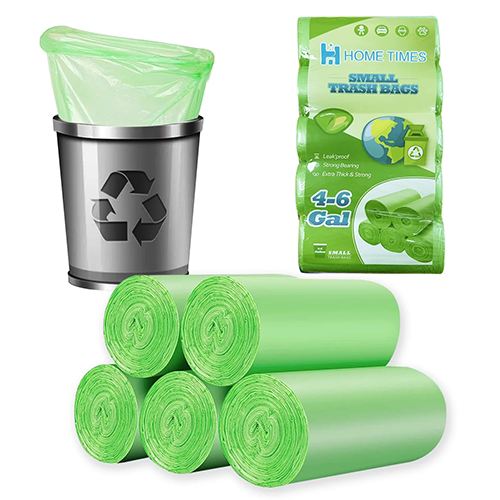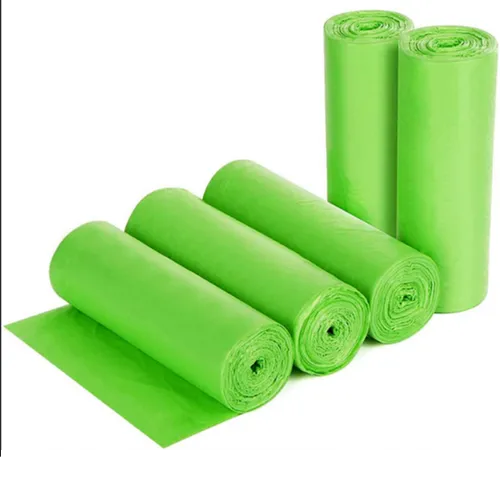How many thickness of biodegradable garbage bag need for cleaning waste ?
September 25, 2023The appropriate thickness or gauge of biodegradable garbage bags can vary depending on the specific needs of individuals. And the types of waste they typically generate. Generally, garbage bags are available in various thicknesses, typically measured in mils or microns. Thicker bags are generally more durable and less prone to tearing, but they can also be more expensive. Here are some guidelines to consider:
Different thickness, different bearing load heavy
- Light Duty (0.5 to 1.2 mils or 12 to 30 microns): Light-duty bags are suitable for collecting lightweight and non-sharp items such as paper, dry leaves, and clothing. They are not recommended for heavy or sharp objects as they may tear easily.
- Medium Duty (1.2 to 2.5 mils or 30 to 63 microns): Medium-duty bags are versatile and can handle a wider range of household waste. It includes kitchen scraps, food packaging, and general household trash. They are less likely to tear under normal use.
- Heavy Duty (2.5 to 4.0 mils or 63 to 100 microns): Heavy-duty bags are designed for handling heavier loads and sharp or bulky items. They are suitable for disposing of items like glass bottles, cans, and sharp-edged waste without tearing.
- Extra Heavy Duty (Over 4.0 mils or 100 microns): Extra heavy-duty bags are the most robust and can handle exceptionally heavy or sharp objects. They fill construction debris, yard waste, and other demanding applications with these biodegradable garbage bags.
When choosing the appropriate thickness for biodegradable garbage bags, consider the following factors:
- The Weight of the Waste: If you regularly dispose of heavy items, it’s advisable to use thicker, heavy-duty bags to prevent leaks and tears.
- Sharp Objects: If your waste includes sharp objects like broken glass or metal cans, thicker bags are more suitable to avoid punctures.
- Environmental Concerns: If you are using biodegradable bags primarily for compostable waste, you may opt for a medium-duty bag. As compostable waste is typically lighter and less likely to damage the bag.
- Cost Considerations: Thicker bags tend to be more expensive. Consider your budget when selecting the appropriate thickness.
- Local Regulations: Be aware of any local regulations or guidelines regarding the use of specific bag thicknesses for waste disposal.
In summary, the choice of biodegradable garbage bag of thickness depends on your specific needs and the types of waste you generate. It’s often a balance between durability, environmental concerns, and cost. Consider the factors mentioned above to determine the right thickness for your household waste management needs.


Biodegradable garbage bags Thickness: 15um – 50um
What kind of biodegaradable garbage bags do customers from european and america area are usually in favor of ?
As customers from european and america area, who certain conscious of eco-friendly. They would use biodegradable garbage bags rather than cheap chemical plastic bags, which have a great impact of environment. So these biodegradable garbage bags have their advantages and chracteristic.
- Light to Medium Duty: Many households in Europe and America often favor light to medium-duty biodegradable garbage bags for their day-to-day waste disposal needs. These bags are suitable for typical household trash, including kitchen waste, paper, and packaging materials. They strike a balance between cost-effectiveness and functionality.
- Composting: In both regions, there is a growing emphasis on composting organic waste. Customers who are environmentally conscious and engage in composting may prefer medium-duty bags for collecting kitchen scraps and compostable materials. These bags are designed to hold compostable waste without tearing easily.
- Recycling: Customers who prioritize recycling may use thinner bags for collecting recyclables like paper, cardboard, and plastic bottles. Recycling bins often have specific requirements for bag thickness. So customers may choose bags that align with these requirements.
- Heavy-Duty for Specialized Needs: For heavy or sharp waste items, such as construction debris, broken glass, or yard waste. Customers in both regions may opt for heavy-duty or extra heavy-duty biodegradable garbage bags to ensure durability and prevent leaks or tears.
- Regulations: Local regulations and waste disposal guidelines can influence the choice of bag thickness. Some municipalities have specific requirements for the thickness of bags used for waste collection, and customers may follow these regulations.
- Environmental Consciousness: Customers who prioritize environmental sustainability may lean toward medium-duty or heavy-duty biodegradable bags. To ensure their waste is securely contained and disposed of in an eco-friendly manner.
It’s important to note that the preferences of customers can vary widely within European and American regions, and individual choices or factors impacted people thought. Such as household waste composition, personal values, budget constraints, and local regulations, as environmental awareness continues to grow, more customers may opt for biodegradable and compostable options to reduce their environmental impact. So regardless of the specific thickness of the bags.

